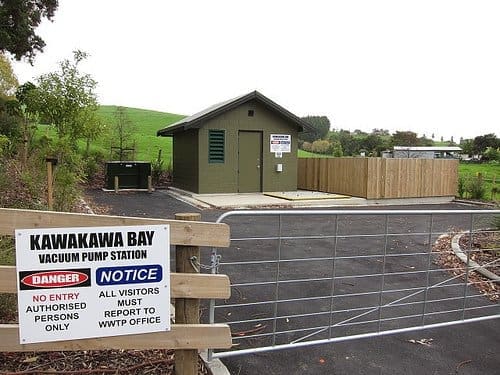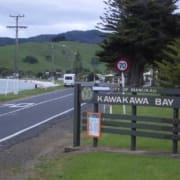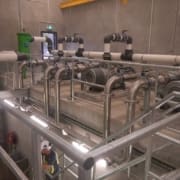NZ’s First Vacuum System Wins Major Environmental Award
wastewater system at Kawakawa Bay, Auckland, New Zealand has been awarded an Environmental and Sustainability Award at the Arthur Mead Awards Function. Flovac’s system was awarded one of three prizes, which was presented by IPENZ, Auckland Branch.
 The awards are named after Auckland City Waterworks Engineer, Arthur Mead, who performed the initial survey and created the designs for Upper Nihotupu and Hia Dams. They are awarded every year to projects that use sustainable features, deal with waste management, avoid negative environmental effects and promote community involvement.
The awards are named after Auckland City Waterworks Engineer, Arthur Mead, who performed the initial survey and created the designs for Upper Nihotupu and Hia Dams. They are awarded every year to projects that use sustainable features, deal with waste management, avoid negative environmental effects and promote community involvement.
As well as fulfilling the requirements of the rewards, Watercare’s project highlighted the close relationship the company maintained with residents and community groups throughout Auckland. Raveen Jaduram, acting chief executive of Watercare, said that one of the company’s main objectives was to improve wastewater treatment services in order to continue to better Auckland’s estuaries, harbours and waterways.
 The celebrated project was designed by engineering consultancy Harrison Grierson with Flovac Systems and constructed by Fulton Hogan. Watercare took over the operation of the Kawakawa Bay system after it had been in operation for a year. Following the implementation of the system, ageing septic tanks in the area could be removed, helping to reduce pollution to local streams and groundwater. The pollution caused by the septic tanks resulted in the Bay being unsafe for swimming in 2002. The safe-for-swimming status was restored at the end of 2012.
The celebrated project was designed by engineering consultancy Harrison Grierson with Flovac Systems and constructed by Fulton Hogan. Watercare took over the operation of the Kawakawa Bay system after it had been in operation for a year. Following the implementation of the system, ageing septic tanks in the area could be removed, helping to reduce pollution to local streams and groundwater. The pollution caused by the septic tanks resulted in the Bay being unsafe for swimming in 2002. The safe-for-swimming status was restored at the end of 2012.
The wastewater project makes use of a Flovac vacuum collection system, which is a first for New Zealand. This allowed for the fast construction of shallow pipelines, reducing the impact on residents in the area.
 Vacuum collection systems allow wastewater from each individual property to drain into a pit before going through a vacuum pipe network. This is controlled through the use of a pneumatically controlled vacuum interface valve in the pit.
Vacuum collection systems allow wastewater from each individual property to drain into a pit before going through a vacuum pipe network. This is controlled through the use of a pneumatically controlled vacuum interface valve in the pit.
Once the wastewater is in the network, it moves to the vacuum pump station through by differential pressure created by opening and closing valves throughout the network. The wastewater is then moved from a collection tank at the pump station to a treatment plant.
– See more at: http://www.envirotech-online.com/news/water-wastewater/9/breaking_news/auckland_wastewater_system_wins_award/31129/#sthash.eTXiUt4g.dpuf
Kawakawa Bay NZ Case Study



 It’s a case of one down and 2599 to go at the biggest subdivision in Christchurch.
It’s a case of one down and 2599 to go at the biggest subdivision in Christchurch. In the second stage, Harakeke, 130 of the 230 sections have sold without being officially released to the market. Titles in that stage will be ready for buyers in June next year.
In the second stage, Harakeke, 130 of the 230 sections have sold without being officially released to the market. Titles in that stage will be ready for buyers in June next year. At 203 hectares, Prestons is on a site bigger than Hagley Park. It is next to the Bottle Lake Forest reserve, and the Waitikiri and Windsor Golf Courses.
At 203 hectares, Prestons is on a site bigger than Hagley Park. It is next to the Bottle Lake Forest reserve, and the Waitikiri and Windsor Golf Courses. He believes the geotechnical report that comes with each section is helping attract buyers.
He believes the geotechnical report that comes with each section is helping attract buyers.